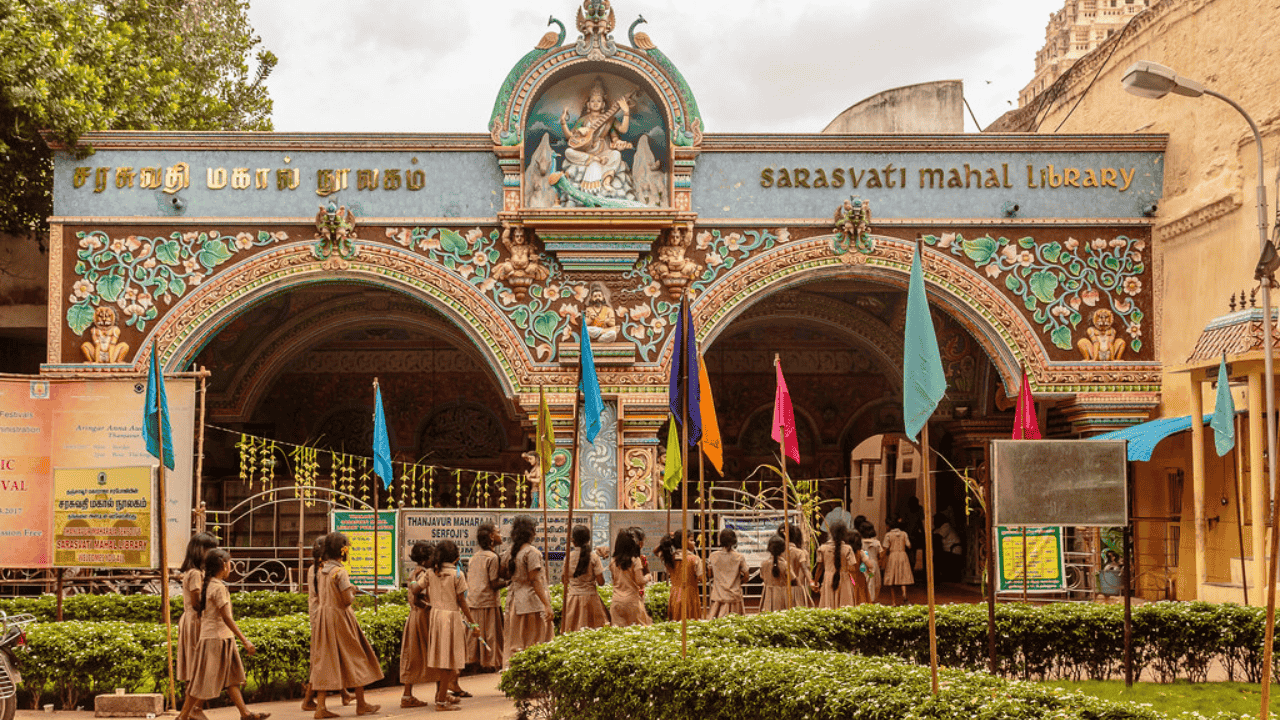Ancient India’s Manuscript Heritage: Saraswati Mahal Library Back in the Spotlight
The Saraswati Mahal Library, located in Thanjavur, Tamil Nadu, is one of India’s oldest and most prestigious repositories of knowledge. Established in the 16th century during the Nayak dynasty and later enriched by the Maratha rulers, this library stands as a unique example of India’s intellectual legacy and is a highly important study point for UPSC and all competitive examinations.
Historical Background and Royal Patronage
Originally established as “Saraswati Bhandar” during the reign of Raghunatha Nayak (1600–1634 CE), the library gained special recognition during the era of Maharaja Serfoji II (1798–1832). The Maratha king, himself a polyglot and scholar, transformed it into an international center of learning. During his 1820 pilgrimage to Varanasi, he appointed numerous scholars to collect rare manuscripts from across the country.
Unique Collection and Global Recognition
This library is listed in the Encyclopedia Britannica as “the most remarkable library in India.” Key features include:
Over 49,000 manuscripts – in Sanskrit, Tamil, Telugu, Marathi, Persian, and other languages
39,000 Sanskrit manuscripts – the largest collection
5,968 Tamil manuscripts – on medicine, literature, music, etc.
3,000 Marathi manuscripts – from the 17th–18th centuries
60,000 printed books – in Indian and European languages
Unique Treasures and Research Significance
The library houses a manuscript that, when read left to right, narrates the Ramayana, and when read right to left, tells the story of Krishna. Other major collections include:
Rare works on Ayurveda and medicine, including patient case studies
Ancient texts on astrology and astronomy
Historical maps and atlases
Thanjavur paintings and other artworks
Scientific treatises – representing 400 years of literary tradition
Preservation and Digitization
Under the National Mission for Manuscripts (now Gyan Bharatam Mission 2024–31), large-scale digitization has been undertaken. Since 2015, thousands of palm-leaf and birch-bark manuscripts have been digitized. The Tamil Nadu government allocated ₹7.50 lakhs for these activities in 2014–15.
Traditional and Modern Conservation Methods
The library uses both traditional and modern methods to preserve manuscripts:
Wrapping in red or yellow cloth (turmeric’s germicidal properties)
Exposing to mild sunlight (to destroy microorganisms)
Natural repellents like neem, ginger, and lemongrass oil
Storage in wooden chests (for climate control)
Research and Academic Importance
Since 1918, the library has functioned as a research center under the District Collector of Thanjavur. Scholars from India and abroad visit for research. Major departments include:
Manuscript conservation
Publication of rare texts (552 books published in 5 languages)
Training in manuscriptology
Microfilming and xerox facilities
Contemporary Relevance and Digital Access
Although only 10–15 readers visit daily, digitization has benefited global researchers. Under the National Mission for Manuscripts, 3.5 lakh manuscripts have been digitized.
Why This Matters for Your Exam Preparation
For UPSC Prelims
Ancient Indian History: Questions on libraries, manuscript traditions, and knowledge preservation
Art and Culture: Thanjavur’s cultural heritage, significance of the library
Geography: Cultural sites of Tamil Nadu
For UPSC Mains
GS Paper I (History): Medieval India, Maratha administration, cultural synthesis
GS Paper I (Culture): Traditional knowledge systems, heritage conservation
Essay topics: Knowledge preservation, cultural heritage, digitization
Key Facts for Competitive Exams
Chronology: 16th century (Nayak foundation) → 18th–19th century (Maratha enrichment) → 1918 (public access)
Royal patronage: Libraries as centers of knowledge
Multilingual heritage: Manuscripts in 10+ languages
Modern initiatives: Digitization, Gyan Bharatam Mission
Major Government Initiatives
National Mission for Manuscripts (2003) → Gyan Bharatam Mission (2024–31), ₹482.85 crore budget
Digital India – cultural heritage preservation
UNESCO Memory of the World Programme – global recognition for Indian manuscripts
Static GK Facts
Location: Thanjavur, Tamil Nadu (within palace complex)
Other names: Thanjavur Maharaja Serfoji’s Saraswati Mahal Library
Founded: 16th century (Nayak period), enriched by Serfoji II (1798–1832)
Global recognition: Encyclopedia Britannica’s “most remarkable library in India”
Saraswati Mahal Library is a unique confluence of India’s ancient knowledge tradition and modern technological preservation. For competitive exams, it is not just about memorizing facts but understanding how traditional knowledge systems contribute to today’s cultural policy and heritage conservation. In India’s digital transformation, such libraries are bridges between the past and the future—making them extremely important for civil service aspirants.
“Why this matters for your exam preparation”
The Saraswati Mahal Library is directly linked to Indian history, culture, knowledge preservation, and digitization. Questions related to its facts, government initiatives, cultural significance, and conservation efforts can be asked in UPSC and other competitive exams. This topic will strengthen your preparation not only for General Studies but also for Essay, Interview, and Optional subjects.
Therefore, studying this library is extremely beneficial for your exam preparation!







